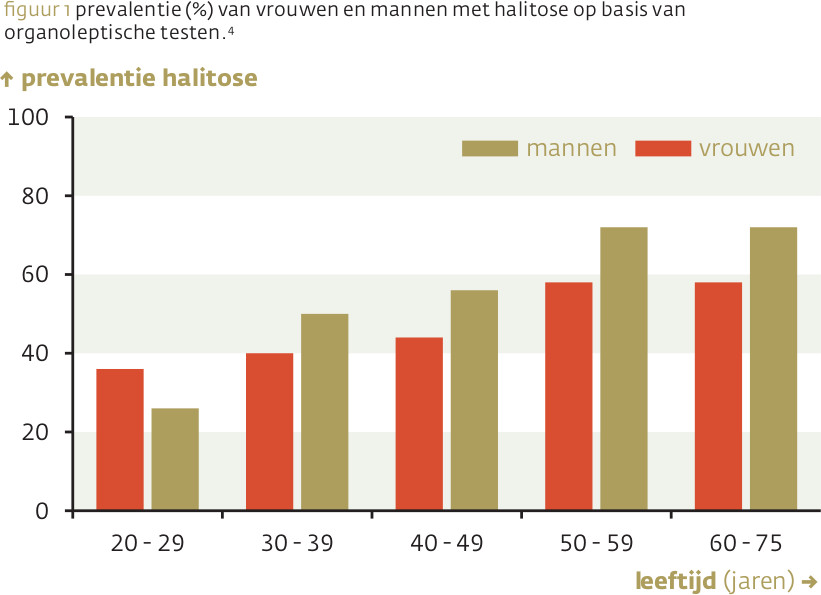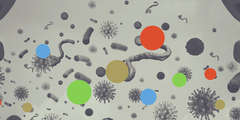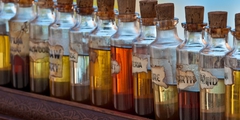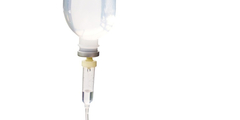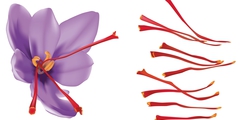
Een slechte adem kan voor veel mensen een trauma zijn. Slechte adem is een taboe; vaak durven alleen de partner of de kinderen aan de bel te trekken. Daarom brengt het onzekerheid met zich mee en kan het tot afzondering leiden. Dit artikel bespreekt diagnostiek, mogelijke oorzaken en behandelwijzen, en daarnaast oplossingen die betrekking hebben op voeding, suppletie en leefstijl.
Beste bezoeker, u heeft geen toegang.
Enkel (web)abonnees hebben toegang tot tijdschriftartikelen. Het webabonnement is nog in de maak.
U kunt zich wel alvast (gratis) registreren en tal van andere webartikelen raadplegen!
Auteur
Trefwoorden:
Verschenen in
Referenties
Van den Broek, A.M.et al.,. A review of the current literature on aetiology and measurement methods of halitosis. Journal of dentistry, 2007, 35.8: 627-635.
Scully, C., Greenman, J. Halitology (breath odour: aetiopathogenesis and management). Oral diseases, 2012, 18.4: 333-345.
Bollen, C.M.L., Beikler, Th. Halitosis: the multidisciplinary approach. International journal of oral science, 2012, 4.2: 55.
Aimetti, M, Perotto S., Castiglione A., Ercoli E. , Romano F. Prevalence estimation of halitosis and its association with oral health-related parameters in an adult population of a city in North Italy. J Clin Periodontol 2015; 42: 1105-1114.
Danser, M. M., et al. Tongue coating and tongue brushing: a literature review. International journal of dental hygiene, 2003, 1.3: 151-158.
Silva, M. F., et al. Is periodontitis associated with halitosis? A systematic review and meta‐regression analysis. Journal of clinical periodontology, 2017, 44.10: 1003-1009.
Quirynen M, Dadamio J, Velde S Van den, et al. Characteristics of 2000 patients who visited a halitosis clinic. J Clin Periodontol 2009; 36: 970-975.
Tangerman A , Winkel EG. Extra-oral halitosis: an overview. J Breath Res 2010; 4: 017003.
Yaegaki, K.; Coil, J. M. Genuine halitosis, pseudo-halitosis, and halitophobia: classification, diagnosis, and treatment. Compendium of continuing education in dentistry (Jamesburg, NJ: 1995), 2000, 21.10A: 880-6, 888-9; quiz 890.
Nani, Bruno Dias, et al. Changes in salivary microbiota increase volatile sulfur compounds production in healthy male subjects with academic-related chronic stress. PloS one, 2017, 12.3: e0173686.
Amou, T., et al. Relationship between halitosis and periodontal disease–associated oral bacteria in tongue coatings. International journal of dental hygiene, 2014, 12.2: 145-151.
Kleinberg, I., M. S. Wolff, and D. M. Codipilly. Role of saliva in oral dryness, oral feel and oral malodour. International dental journal, 2002, 52.S5P1: 236-240.
Koshimune, S., et al. Low salivary flow and volatile sulfur compounds in mouth air. Oral Surgery, Oral Medicine, Oral Pathology, Oral Radiology, and Endodontology, 2003, 96.1: 38-41.
Pajukoski, H., et al. Prevalence of subjective dry mouth and burning mouth in hospitalized elderly patients and outpatients in relation to saliva, medication, and systemic diseases. Oral Surgery, Oral Medicine, Oral Pathology, Oral Radiology, and Endodontology, 2001, 92.6: 641-649.
Pol, A, et al. Mutations in SELENBP1, encoding a novel human methanethiol oxidase, cause extraoral halitosis. Nature genetics, 2018, 50.1: 120.
Greenman J, Duffield J, Spencer P, et al. Study on the organoleptic intensity scale for measuring oral malodor. J Dent Res 2004; 83: 81-85.
Wigger-Alberti W, Gysen K, Axmann EM, Wilhelm KP. Effi cacy of a new mouthrinse formulation on the reduction of oral malodour in vivo. A randomized, double-blind, placebo-controlled, 3 week clinical study. J Breath Res 2010; 4: 017102.
Murata, T., et al. Classification and examination of halitosis. International dental journal, 2002, 52.S5P1: 181-186.
Mantilla Gómez S, Danser MM, Sipos PM, et al. Tongue coating and salivary bacterial counts in healthy/gingivitis subjects and periodontitis patients. J Clin Periodontol 2001; 28: 970-978.
Winkel EG, Roldán S, Winkelhoff AJ van, Herrera D, Sanz M. Clinical effects of a new mouthrinse containing chlorhexidine, cetylpyridinium chloride and zinclactate on oral halitosis. A dual-center, double-blind placebo-controlled study. J Clin Periodontol 2003; 30: 300-306.
Saad S, Greenman J. Tongue biofilm areal density and tong coating index. J Breath Res 2008; 2: 017008
de Jong, T. M. H., and M. L. Laine. Serie: Preventieve tandheelkunde Halitose de mond uit helpen. Ned Tijdschr Tandheelkd, 2017, 124: 365-368.
Tangerman A. Halitosis in medicine: a review. Int Dent J 2002; 52: 201–206.
Krespi, Y. P., Shrime, M. G., & Kacker, A. The relationship between oral malodor and volatile sulfur compound–producing bacteria. Otolaryngology—Head and Neck Surgery, 2006, 135.5: 671-676.
Zaura E, Keijser BJ, Huse SM, Crielaard W. Defining the healthy “core microbiome” of oral microbial communities. BMC Microbiol 2009; 15: 259.
Preza D, Olsen I, Willumsen T, Grinde B, Paster BJ. Diversity and sitespecificity of the oral microflora in the elderly. Eur J Clin Microbiol Infect Dis 2009; 28: 1033-1040.
Calil, C., et al. The relationship between volatile sulphur compounds, tongue coating and periodontal disease. International journal of dental hygiene, 2009, 7.4: 251-255.
Yaegaki, K., Sanada, K. Volatile sulfur compounds in mouth air from clinically healthy subjects and patients with periodontal disease. Journal of periodontal research, 1992, 27.4: 233-238.
Tanaka, Muneo, et al. Contribution of periodontal pathogens on tongue dorsa analyzed with real-time PCR to oral malodor. Microbes and infection, 2004, 6.12: 1078-1083.
Greenman, John, et al. Study on the organoleptic intensity scale for measuring oral malodor. Journal of dental research, 2004, 83.1: 81-85.
Persson, S., et al. The formation of hydrogen sulfide and methyl mercaptan by oral bacteria. Oral microbiology and immunology, 1990, 5.4: 195-201.
Seemann, Rainer, et al. Halitosis management by the general dental practitioner—results of an international consensus workshop. Journal of breath research, 2014, 8.1: 017101.
Bradshaw, D. J., et al. Creation of oral care flavours to deliver breath‐freshening benefits. Oral diseases, 2005, 11: 75-79.
Kapoor, Uditi, et al. Halitosis: Current concepts on etiology, diagnosis and management. European journal of dentistry, 2016, 10.2: 292.
Van der Sleen, M. I., et al. Effectiveness of mechanical tongue cleaning on breath odour and tongue coating: a systematic review. International journal of dental hygiene, 2010, 8.4: 258-268.
Wang, J.; HE, L. Effect of mechanical self-cleaning of tongue coating on malodor in halitosis patients originating from tongue coating. Beijing da xue xue bao. Yi xue ban= Journal of Peking University. Health sciences, 2017, 49.2: 344-348.
Bordas A, McNab R, Staples AM, Bowman J, Kanapka J, Bosma MP. Impact of different tongue cleaning methods on the bacterial load of the tongue dorsum. Arch Oral Biol 2008; 53 (Suppl. 1): S13-S18
Quirynen M, Avontroodt P, Soers C, Zhao H, Pauwels M, Steenberghe D van. Impact of tongue cleansers on microbial load and taste. J Clin Periodontol 2004; 31: 506-510.
Seemann R, Kison A, Bizhang M, Zimmer S. Effectiveness of mechanical tongue cleaning on oral levels of volatile sulfur compounds. J Am Dent Assoc 2001; 132: 1263-1267.
Bosy A, Kulkarni GV, Rosenberg M, McCulloch CAG. Relationship of oral malodor to periodontitis: evidence of independence in discrete subpopulations. J Periodontol 1994; 65: 37-46.
Slot, D.E., et al. Treatment of oral malodour. Medium‐term efficacy of mechanical and/or chemical agents: a systematic review. Journal of clinical periodontology, 2015, 42: S303-S316.
Laine, M. L., et al. Halitose. Een probleem van velen. Ned Tijdschr Tandheelkd, 2011, 118: 607-611.
Graziano, Talita Signoreti, et al. In vitro effects of Melaleuca alternifolia essential oil on growth and production of volatile sulphur compounds by oral bacteria. Journal of Applied Oral Science, 2016, 24.6: 582-589.
Nishihira, Jun, et al. Effects of 4-week continuous ingestion of champignon extract on halitosis and body and fecal odor. Journal of traditional and complementary medicine, 2017, 7.1: 110-116.
Janczarek, Magdalena, et al. The role of probiotics in prevention of oral diseases. Postepy higieny i medycyny doswiadczalnej (Online), 2016, 70: 850-857.
Seminario-Amez, M., et al. Probiotics and oral health: A systematic review. Medicina oral, patologia oral y cirugia bucal, 2017, 22.3: e282.
Yoo, Jun-Il, et al. The Effect of Probiotics on Halitosis: a Systematic Review and Meta-analysis. Probiotics and antimicrobial proteins, 2017, 1-8.
Banas, Jeffrey A.; POPP, Eric T. Recovery of viable bacteria from probiotic products that target oral health. Probiotics and antimicrobial proteins, 2013, 5.3: 227-231.
Akkaoui S., Keltoum Ennnibi , O.,. Use of traditional plants in management of halitosis in a Moroccan population. Journal of intercultural ethnopharmacology, 2017, 6.3: 267.
Sultan, Z., et al. Green tea (Camellia Sinensis): chemistry and oral health. Open Dent J, 2016, 10: 3-10.
Singhal, K., et al. Probable benefits of green tea with genetic implications. Journal of oral and maxillofacial pathology: JOMFP, 2017, 21.1: 107.
Shanbhag, Vagish Kumar L. Oil pulling for maintaining oral hygiene–A review. Journal of traditional and complementary medicine, 2017, 7.1: 106-109.
Peedikayil, F. C.et al. Effect of coconut oil in plaque related gingivitis—A preliminary report. Nigerian medical journal: journal of the Nigeria Medical Association, 2015, 56.2: 143.
Shino, B., et al. Comparison of antimicrobial activity of chlorhexidine, coconut oil, probiotics, and ketoconazole on Candida albicans isolated in children with early childhood caries: an in vitro study. Scientifica, 2016, 2016.
Kaushik, M., et al. The effect of coconut oil pulling on Streptococcus mutans count in saliva in comparison with chlorhexidine mouthwash. J Contemp Dent Pract, 2016, 17.1: 38-41.
Ogbolu, D. O., et al. In vitro antimicrobial properties of coconut oil on Candida species in Ibadan, Nigeria. Journal of medicinal food, 2007, 10.2: 384-387.
VERALLO-ROWELL, Vermén M.; DILLAGUE, Kristine M.; SYAH-TJUNDAWAN, Bertha S. Novel antibacterial and emollient effects of coconut and virgin olive oils in adult atopic dermatitis. Dermatitis, 2008, 19.6: 308-315.
Astor, F.C. et al., Xerostomia: a prevalent condition in the elderly. Ear, nose & throat journal, 1999, 78.7: 476.
Morita, M.et al.. Association between oral malodor and adult periodontitis: a review. Journal of clinical periodontology, 2001, 28.9: 813-819.
Nagata H, et al. Effect of eucalyptus extract chewing gum on periodontal health: a double-masked, randomized trial. J Periodontol. 2008;79(8):1378-1385
Navbavi, S.,, et al. Antibacterial effects of cinnamon: From farm to food, cosmetic and pharmaceutical industries. Nutrients, 2015, 7.9: 7729-7748.
Chaudhari,L.K.;Jawale,B.A.;Sharma,S.;Sharma,H.;Kumar,C.D.;Kulkarni,P.A.Antimicrobial activity of commercially available essential oils against Streptococcus mutans. J. Contemp. Dent. Pract. 2012, 13, 71–74
Nair, Gopakumar Ramachandran, et al. Clinical effectiveness of aloe vera in the management of oral mucosal diseases-a systematic review. Journal of clinical and diagnostic research: JCDR, 2016, 10.8: ZE01.
Mayaud L., Carricajo A., Zhiri A., Aubert G. Comparison of bacteriostatic and bactericidal activity of 13 essential oils against strains with varying sensitivity to antibiotics. Letters in Applied Microbiology. 2008;47(3):167–173.
Wu, X., et al. Whether Chinese Medicine Have Effect on Halitosis: A Systematic Review and Meta-Analysis. Evidence-Based Complementary and Alternative Medicine, 2018, 2018.
Tahani, B.; SABZIAN, Roya. Effect of Camellia sinensis plant on decreasing the level of halitosis: A systematic review. Dental research journal, 2018, 15.6: 379.
Erawati, S. et al. Clinical Efficacy of a New Mouthwash Containing Essential Oil of Cardamom in Reducing Volatile Sulphur Coumpounds Concentration. International Journal of Clinical Preventive Dentistry, 2014, 10.4: 237-242.
Lourith N, Kanlayavattanakul M. Review article: Oral malodour and active ingredients for treatment. Int J Cosmetic Sci. 2010; 32(5): 321-329.
Fahmimi, Sh., Naseri, M. Anti-halitosis plants in Iranian traditional medicine. Research Journal of Pharmacognosy, 2015, 2.2: 61-66.

